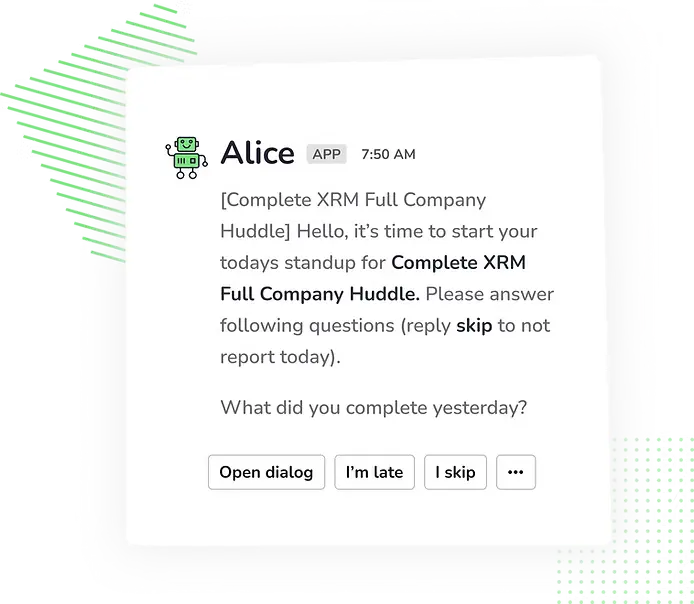In today’s fast-paced work environment, effective communication and collaboration are more critical than ever. Teams need a way to stay aligned, address roadblocks quickly, and maintain momentum on projects. Enter the daily huddle: a short, focused meeting designed to do just that. This article will explore what a daily huddle is, its numerous benefits, and the best practices for implementing one successfully within your team. Whether you’re a seasoned manager looking to optimize team performance or a team member seeking more efficient workflows, understanding the power of the daily huddle can significantly impact your productivity and overall team success.
What Is a Daily Huddle?
A daily huddle is a short, structured meeting, typically held at the start of each workday, where team members quickly align on priorities, track progress on key tasks, and address any immediate challenges. This brief, focused gathering can be conducted in-person or remotely, making it adaptable for various team structures. The daily huddle serves as a vital tool for maintaining team momentum, fostering communication, and ensuring everyone is on the same page.
Benefits of A Daily Team Huddle
Daily team huddles, or stand-up meetings, have become a staple in many workplaces due to their numerous benefits. These short, focused meetings provide a platform for teams to connect, align, and efficiently tackle daily tasks. By fostering open communication, promoting collaboration, and ensuring everyone is on the same page, daily huddles can significantly enhance team productivity and overall performance.
1. Team Alignment and Focus
Daily huddles act as a touchstone, ensuring the entire team is on the same page by clearly communicating daily priorities and their connection to broader strategic goals. This shared understanding fosters a sense of purpose and direction, preventing individuals from working in silos and maximizing collective effort towards common objectives.
2. Improved Communication
Daily huddles establish a consistent communication rhythm, creating a predictable and efficient flow of information. This regular interaction reduces misunderstandings and misinterpretations, as team members have a dedicated space to clarify any questions or concerns. The concise nature of these meetings encourages focused discussions, preventing unnecessary tangents and maximizing the value of the limited time allotted.
3. Enhanced Problem-Solving
Daily huddles provide a dedicated forum for quickly identifying and addressing obstacles hindering progress. This proactive approach to problem-solving allows teams to tackle challenges in real-time, preventing them from escalating and impacting project timelines. By sharing roadblocks openly, team members can leverage collective knowledge and resources to find effective solutions collaboratively.
4. Increased Employee Engagement
Daily huddles contribute to increased employee engagement by providing a regular platform for all team members to share updates, voice their perspectives, and contribute to the team’s collective efforts. This inclusive environment fosters a sense of ownership and belonging, making individuals feel valued and more invested in the team’s success.
5. Better Time Management
Daily huddles, by their very nature, promote better time management. These short, focused meetings ensure discussions remain concise and actionable, preventing them from sprawling into unproductive, time-consuming affairs. This efficient use of time allows teams to quickly address key issues and get back to their core tasks, maximizing productivity throughout the workday.
Daily Huddles vs. Standups vs. Scrum Meetings
For most purposes, these are really synonyms and they have the same or similar purposes. Most people and organizations would choose to refer to their Daily Standup Scrum meeting with some version of these 3 names. All three are short, recurring meetings, with some structured agendas. While the term “scrum meeting” originated with the Agile movement and is popular in technology companies, the term “Daily huddle” seems to be popular with all industries. The term standup is used to reinforce the idea that the meeting should be short enough that participants can stand and not get tired or want to sit down. Any of these meeting names can be used to accomplish the same purpose.
12 Best Practices for Effective Daily Huddle Meetings
For daily huddles to truly deliver on their promise, they need structure, consistency, and clear expectations. Implementing these best practices will ensure your daily huddles are productive, engaging, and contribute meaningfully to team success.
1. Keep Meetings Short and Focused
Daily huddles should be concise, ideally lasting no more than 10-15 minutes, to maintain energy and engagement. Brevity allows the team to focus on actionable updates and avoid getting bogged down in detailed problem-solving or unrelated tangents. Setting time limits for each agenda item can help prevent overruns and ensure the meeting stays on track. This focused approach maximizes the value of the limited time and keeps everyone energized.
2. Follow a Consistent Daily Huddle Agenda
A structured agenda helps teams stay organized and efficient by outlining key topics like progress updates, daily priorities, and current challenges. Consistency in the agenda allows team members to prepare in advance, maximizing the productivity of the huddle. A simple and effective agenda format could be “yesterday’s accomplishments, today’s priorities, and current roadblocks.” This structure ensures all crucial areas are covered.
3. Involve Relevant Team Members
Only include team members directly involved in the tasks or decisions being discussed to keep the conversation focused and avoid wasting time for those not directly affected. Balancing inclusivity with relevance is crucial, ensuring all voices are heard where applicable, but avoiding unnecessary attendance. This targeted approach ensures efficient use of everyone’s time.
4. Rotate Leadership Responsibilities
Rotating leadership roles among team members fosters engagement, develops leadership skills, and ensures shared ownership of the huddle process. Relying on one consistent facilitator can lead to burnout or disengagement. Clear guidance for leaders, such as maintaining the agenda and keeping discussions on track, is essential for smooth transitions. Shared leadership empowers the whole team.
5. Adapt for Remote and Distributed Teams
Remote teams face unique challenges like time zone differences and a lack of face-to-face interaction. Overcoming these requires deliberate strategies, including the consistent use of video conferencing and asynchronous updates for inclusivity. Leveraging appropriate tools and techniques ensures seamless participation from all remote team members, regardless of location.
6. Use Visual Aids or Tools
Visual aids like dashboards, charts, or KPI fire present data clearly and concisely, reducing the need for lengthy explanations and keeping the team focused on progress. Examples of effective visuals include progress charts, real-time performance metrics, and project timelines. These tools provide a quick overview of key information.
7. End with Clear Next Steps
Summarizing key takeaways and assigning actionable tasks before concluding the meeting is crucial for ensuring accountability and providing clarity on what each team member needs to do next. Include deadlines for these tasks. Strategies for assigning deadlines and following up on action items after the meeting are essential for driving progress.
8. Stick to a Regular Time and Place
Holding huddles at the same time and place (or virtual platform) each day creates a predictable routine and minimizes delays. Consistency is key to building a rhythm for the team’s day and fostering a sense of shared purpose. Accommodating team members in different locations or time zones requires careful planning and communication.
9. Document Key Takeaways
Documenting key decisions, assigned tasks, and deadlines during the huddle maintains alignment and ensures everyone is on the same page. Shared notes allow team members to refer back to action items and stay informed even if they were unable to attend. Choosing a designated note-taker and sharing the documentation effectively are vital for knowledge sharing.
Huddle boards can be used to visually capture and document key takeaways from daily or weekly huddles, ensuring that important decisions, action items, and lessons learned are readily accessible to the team. By dedicating a section of the board to “Key Takeaways” or “Action Items,” teams can quickly record and track critical information, promoting transparency and accountability. Discover innovative ways to visually capture and organize key takeaways by exploring different huddle board examples.
10. Encourage Active Participation
Creating an inclusive environment where all team members feel encouraged to contribute updates or raise concerns is essential for a successful huddle. Active participation leads to better engagement, collaboration, and problem-solving. Techniques like round-robin updates can ensure quieter team members have a chance to speak and contribute.
11. Keep it Positive
Incorporating moments of positivity, such as recognizing achievements or celebrating milestones, boosts morale and sets a constructive tone for the day. Positivity fosters a supportive team culture and strengthens team bonds. Simple morale-boosters, like sharing a recent success story or expressing gratitude, can make a big difference.
12. Address Off-Topic Issues Separately
Staying focused is crucial; set aside unrelated topics for follow-up discussions outside the huddle. This approach keeps the meeting on track without dismissing important but non-urgent matters. Creating a “parking lot” list for later review is a helpful strategy for managing off-topic issues efficiently.
The Ultimate Daily Huddle Tool: StandUp Alice
Using StandUp Alice for your daily huddles can streamline the process and enhance its effectiveness. Here’s how StandUp Alice can help, along with some best practices to maximize its use:
Structured Format
StandUp Alice provides a pre-defined structure for your huddles, ensuring consistency and covering key areas like accomplishments, priorities, and roadblocks. This eliminates the need to create an agenda from scratch each time.
Automated Reminders
Set up automated reminders to ensure everyone is prepared for the huddle and submits their updates on time. This helps maintain consistency and punctuality.
Asynchronous Updates
Team members can submit their updates asynchronously before the actual huddle, saving valuable meeting time. This allows everyone to come prepared and focus the live meeting on discussion and problem-solving.
Centralized Information
All huddle updates are stored in one central location, making it easy to track progress, identify trends, and review past huddles. This creates a valuable record of team activity.
Roadblock Tracking
StandUp Alice often includes features for tracking roadblocks and assigning owners to address them. This ensures that issues are not forgotten and are actively worked on.
Integrations
Many StandUp tools integrate with other project management and communication tools, further streamlining workflows and centralizing information.
Reporting and Analytics
Some tools offer reporting features that provide insights into team performance, identify bottlenecks, and track progress towards goals.

daily huddle
Elevate Your Daily Huddle Meeting with KPI Fire
Daily huddles are a powerful tool for boosting team performance. As we’ve explored, they foster team alignment by ensuring everyone is on the same page, improve communication by establishing a regular rhythm of information sharing, and drive productivity by focusing efforts on key priorities. These short, focused meetings keep teams engaged and motivated, contributing directly to the achievement of strategic goals. By consistently applying the best practices we’ve discussed – from keeping meetings concise and focused to encouraging active participation and documenting key takeaways – you can maximize the impact of your daily huddles.
Leveraging Huddle Boards
A huddleboard serves as a visual focal point during daily huddles, displaying key performance indicators and current project statuses, allowing teams to quickly identify roadblocks and track progress. During the huddle, teams use the board to share updates, address immediate concerns, and align on daily priorities, fostering rapid communication and problem-solving. Learn how to use a huddle board here.
Simplifying Planning & Execution
KPI Fire simplifies the planning and execution of these essential meetings, taking them to the next level. Our platform provides the tools you need to effectively track key metrics, align daily priorities with overarching strategic objectives, and maintain accountability across the team. With KPI Fire, you can transform your daily huddles from simple updates into powerful drivers of performance improvement.
Ready to elevate your team’s performance with more effective daily huddles? Request a demo of KPI Fire today and discover how we can help you unlock your team’s full potential.
FAQs
What Should Be in A Daily Huddle?
A daily huddle is a quick team meeting (5-15 minutes) focused on current work. It should cover: What was done yesterday (brief updates on completed tasks), What’s planned for today (focus on top priorities), and Roadblocks (identify any obstacles). Keep it concise, action-oriented, and collaborative. The goal is alignment and removing impediments, not in-depth problem-solving.
How Long Should a Daily Huddle Be?
Daily huddles should be short and focused, ideally lasting no more than 15 minutes. Sticking to this time limit ensures efficiency and prevents the meeting from becoming a burden. The goal is a quick check-in to align on priorities, address roadblocks, and share brief updates, not lengthy discussions. Respecting everyone’s time is crucial for productive huddles.
What Time of Day Is Best for Daily Team Huddles?
Mornings are generally best, setting the tone for the day and allowing for quick adjustments. However, the ideal time depends on your team’s work schedule and preferences. Consider what time allows for maximum attendance and engagement.
Who Are the Key Participants in A Daily Huddle?
Anyone directly involved in the team’s work should participate. This typically includes team members, project managers, and sometimes stakeholders. The key is to include those who need to be informed and contribute to daily coordination.
How to Start a Daily Huddle?
Gather your team briefly (5-15 minutes) at a consistent time and place. Start with a quick round-robin sharing daily priorities, roadblocks, and wins. Keep it focused and action-oriented. End with a quick recap and any necessary follow-up.
How Do You End a Huddle?
Summarize key takeaways and action items. Confirm who’s responsible for what and by when. Thank the team for their contributions. Keep it concise and positive, setting the tone for the day.
How to Make Daily Huddles Fun?
Keep them short and sweet. Incorporate team celebrations (small wins!). Use icebreakers or energizers occasionally. Encourage open communication and a positive atmosphere. Vary the format sometimes.




